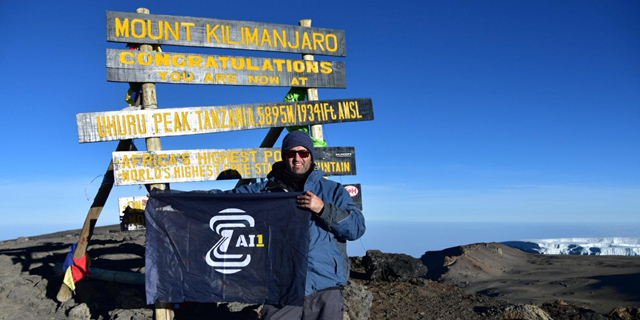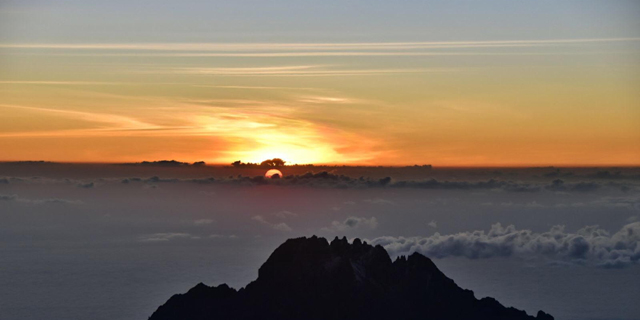
Learning to Go Slower on Mount Kilimanjaro
When climbing on the Kilimanjaro, tech entrepreneur Eyal Gura had a realization about the healthcare startup life cycle
Last week I found myself short of breath a few times. This wasn't due to my regular start of the day at Zebra Medical Vision Ltd., but rather a part of summiting Mount Kilimanjaro, also known as the rooftop of Africa, for my 40th birthday.
More by CTech
We made it to the top and back in one piece, and while watching the sunrise come up through the clouds beneath your feet is a unique experience, this was not the main takeaway I wanted to share with you.
What really resonated with me during the trip was the notion of “pole pole”. In Swahili "pole pole" translates to slowly, gently, softly, quietly, slow down.
We kept hearing these words from our local guides during our climb to the summit. They were very strict and made sure we kept to the correct, slow pace. Why? Because around 50,000 people attempt to climb Mount Kilimanjaro every year, but the chances of reaching its summit are highly dependent on the number of days devoted to the ascent. The more days, the higher the probability of success, as your body has more time to adapt and acclimatize to the change.
The most recent data reported by the Tanzania National Park authorities show climbers have a 45% chance of summiting. However, when you take a closer look at those numbers, you see that climbers who take eight day routes were around three times more likely to summit compared to climbers who tried ascending in five days.
So, what's the relation between startups and altitude sickness?
While every industry evolves at a different pace, most startups seem to think (encouraged by investors and venture capital funds) the choice is between quick growth and failure. Scale, expand quickly, open new territories and announce more news: this is who we are and this is how our brains are conditioned as entrepreneurs and venture capitalists.
Back in Tanzania, I was trying to catch my breath on the way to the top (of an actual mountain); there is not a lot of oxygen when you are at 5,900 meters. I kept hearing “pole pole” and thinking about the “peak summiting” statistics of startups (less than 10%) and how counterintuitive it seems to us as entrepreneurs to actually slow down in order to maximize our chances of summiting. Is this one of the reasons why so many startups fail so fast or don't go the distance? Is it all a matter of altitude sickness?
The symptoms and side effects of “startup altitude sickness” seem to include:
- Irrational public relations and funding within the first 1-2 years
- Jumping into a relationship with co-founders you don’t know just because of their AI-Google-Facebook-Stanford (fill in the blanks) pedigree filled resume
- Too many vice presidents in the company's second and third years
- Unexplainable valuations (hint: adding the term AI is not an explanation) in the first rounds and a lot of VC praise without any good references from real customers
- Founders that spend more time on stages and at events than with their teams and customers.
Unfortunately, in the healthcare field these accumulate and distance the clinical community from trying out new innovations. After reflecting on the wisdom imparted by my guides based on countless years of accumulated experience, and applying it to my world and my own experience working at and amongst various healthcare startups, I'd like to offer the following suggestions:
- Create a team that can go the distance and don't blindly believe you have the right team until you see them working together.
- Focus on meaningful work (and relationships) with customers and prospects. Listen to their needs and try to make their dreams come true but pace it correctly.
- Develop your data constantly. Clean it, get more of it than you ever think you’ll need, and really challenge it. AI output is only as good as its input data.
- Pick the right investors to guide you on the way to the summit. These are not necessarily the ones that will give you the highest valuation, throw the coolest parties or post all over Twitter regularly.
- Be patient with bureaucracy. Working through rules and regulations takes time and costs money.
- keep in mind that regulators are professional experts that are genuinely interested in keeping patients safe (and less interested in the buzz around AI if it cannot produce actionable items for them).
- Validate your innovation patiently and publish research. This takes time, deep digging, and a very long breath span but it is necessary. You need to gradually establish your reputation in the busy and conservative clinical community, which has seen too many startups suffering from altitude sickness.
Zebra is not my first (or second or third, for that matter) startup but it is my first healthcare company. In the first few years I was still trying to forcefully resist the pace of the field, the regulatory affairs and the clinical decision-making processes at hospitals. I could not understand why everything takes five times longer than in other industries while there were suffering patients whose lives could be improved through much-needed innovation. People kept telling us we were moving too fast, creating too many algorithms without knowing enough about the clinical use or regulatory pathway, and generating too much data to deal with all at once.
They were right, and it did take a few years to start recognizing the right pace for climbing our way to the summit.
While we are still far from being there, I am very proud of what the team has learned in the last four years. We’ve moved forward—developing our foundation and watching our steps—with scientific projects and with developing a platform of real and validated products that doctors will actually be able to use.
I am still reflecting on this Mount Kilimanjaro experience and on how each startup needs to find the right pace and pathway to fit its industry. In the meantime at Zebra, we’ve managed to stick to our commitments and also speed things up just a bit industry-wise.
We’re now preparing something we’re very proud of for health providers and patients globally. Yes, even in Africa.
Eyal Gura is an active venture investor and the co-founder and chairman of Zebra Medical Vision Ltd., a medical imaging and AI startup. He was a venture partner at Pitango Venture Capital and is a founding investor of Ebay's theGiftsProject. Mr. Gura previously founded PicApp Ltd., an editorial content syndication platform, and image monitoring company PicScout. He is also a faculty member at the Zell entrepreneurship program at Interdisciplinary Center Herzliya and a Young Global Leader of the World Economic Forum.


1 Comment Add Comment